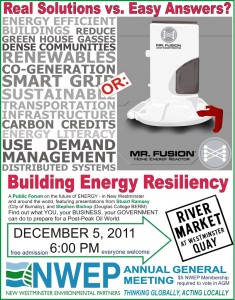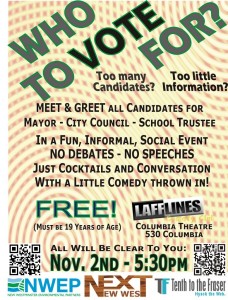Editors note: I first posted this on December 18, 2011. but somehow (likely my ham-fisted Blogsy iPad Interface doofusness) it got lost. I posted a follow-up on the 26th of December, but with the context removed, the second post makes less sense, so here is the original post, repeated in exactitude (even though I have learned more about this subject since December 18th, I will post this as the original for posterity, then write something in the next few days to update the update of my update. Get it?
There was apparently a Rally Thursday night to “Save the Parkade”. It was not well advertised outside of the Downtown Merchants, and I only heard of it through the blog of Adam Goss (oh, by the way, Adam Goss has a new blog – worth reading!) I am on the record about my feelings around the Parkade and the future of Front Street, so I won’t bore you here. But I was intrigued by the flyer information provided via Adam’s Blog. To a point:
“Downtown Merchants and Landlords have not seen any line of reasoning from city hall showing that removal of the Parkade or reduction in parking will improve business.”
Interesting, but I haven’t heard the City suggest it will improve business. They have said that the Parkade is underutilized, falling apart, and that repairing it will be expensive. There are however many of us who suggest that Downtown would benefit from being connected to the waterfront and from having a vibrant Front Street for commercial businesses, and removing the Parkade may facilitate those things.
“Merchants and landlords will lose over $6,000,000 in rents and personal income during the West Parkade demolition and Front Street realignment process.”
I am intrigued about where this number came from, and how it compares the “rents and personal income” that will come from having storefronts on Front Street.
“Removing 283 parking spaces and replacing them with only 36 much despised back in angle meter parking spaces will not be adequate for area prosperity.”
I guess I would return the question with asking how many empty parking spots are required in order to provide adequate prosperity? The studies on the Parkade have shown peak usage of less than 38% of the 741 spots: meaning that even after the above-mentioned changes are made, there will still be 200+ empty spots in the remaining half of the Parkade.
“Other than the East Parkade, there are no monthly or multiple hour parking spaces available for our workforce. Not everyone takes the train to work.”
As noted, there are still going to be 200+ unused spots in the East Parkade, and you can park all day for $5 at Douglas College (you don’t need to be a student), and you can park at the Quay. As to the ending non sequitor argument about trains, just how many cars is each employee planning to bring to work? And what incentives are you giving your employees to not drive to work, saving precious parking for your customers?
“The city has not implemented any long term plan to create decentralized parking spaces. In fact, most new developments have relaxed parking requirements.”
I agree with this statement. The City needs to develop a realistic plan for decentralized parking in Downtown New West before they remove the East Parkade. Clearly, the West Parkade is not needed (see empty space numbers above), but I think that knocking it down without a plan in place is bad planning. Removing it without a plan is silly, but so is dumping money into maintaining a bad piece of infrastructure that is not being used and is causing other negative effects. Will the merchants accept a plan that suggests that parking is currently adequate without the Parkade, if that is what the study finds?
“The parkade is a $20,000,000 revenue generating, downtown revitalizing, asset to save, not to destroy. Smart money would invest in its rehabilitation and enhancement.”
Where is this revenue number coming from? Surely the Downtown Parking Commission is not getting $20 Million from selling fewer than 200 parking spots a day. Clearly, the smart money is not in rehabilitation, but in planned removal.
“The parkade and Front Street are in need of a long term vision including noise abatement, safety, maintenance, beautification and enhancement.”
Agreed. A long-term vision for Front Street is needed. Part of that long-term vision will be evaluating whether last century’s parking solution makes sense over the next 20 to 50 years. Safety, maintenance, beautification and enhancement of Front Street will all be facilitated with the removal of the Parkade.
“The parkade was created by the merchants, paid by merchants and its fate and management should be controlled by merchants.”
Interesting argument. My understanding of the history of the Parkade is that it was built at the end of 1950s to coincide with the decline of Columbia Street as a destination when auto-oriented shopping centres began popping up in Coquitlam and Burnaby and other areas, and the Woodwards opened in Uptown. At the time, parking seemed to be the Bright Idea about how to develop a shopping area. Even in the 1960s, this didn’t work for Downtown, so more of a bad cure was applied, and the Parkade was expanded, and Columbia Street continued to decline. It wasn’t until SkyTrain arrived in the late 1980s that Columbia began to turn around, and the despised back in angle parking introduction of the Road Diet in the last few years has also made the street a better place to visit, walk, and shop. All along, the Parkade was underutilized, and never provided the boost to business for which it was designed.
I stand to be corrected, but I thought the Parkade was built by the City, not the merchants, although it was the merchants who lobbied the City to build it in the 50s, and lobbied to have it expanded in the 60s. It was the merchants who more recently recognized the Parkade was underutilized, and lobbied the City to advertise the Parkade as a park-and-ride destination, ironically complaining that we need more parking at the same time as trying to find ways to fill empty parking spots. Merchants are important, and addressing their needs is a fundamental duty of City Hall. However, the Downtown Merchants have no more or less right to decide the fate of a public resource than Residents or other community stakeholders do. So I hope what comes out of the Rally is a public conversation about the fate of the Parkade, not a confrontational keepit vs. killit debate that lacks rational analysis of the needs of all stakeholders.
I also think that there are other things the Downtown Merchants could direct their energy towards. While researching for this post, I ran across this interesting Masters Thesis on the topic of Columbia Street and potential for urban renewal. It is a good read, and since it is a few years old. It is good to see some of the recommendations coming out of it (changes to Hyack Square, the establishment of a Community Centre downtown) are already arriving.

